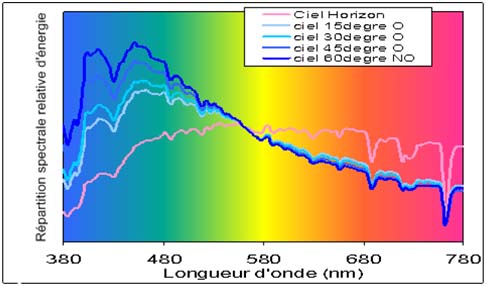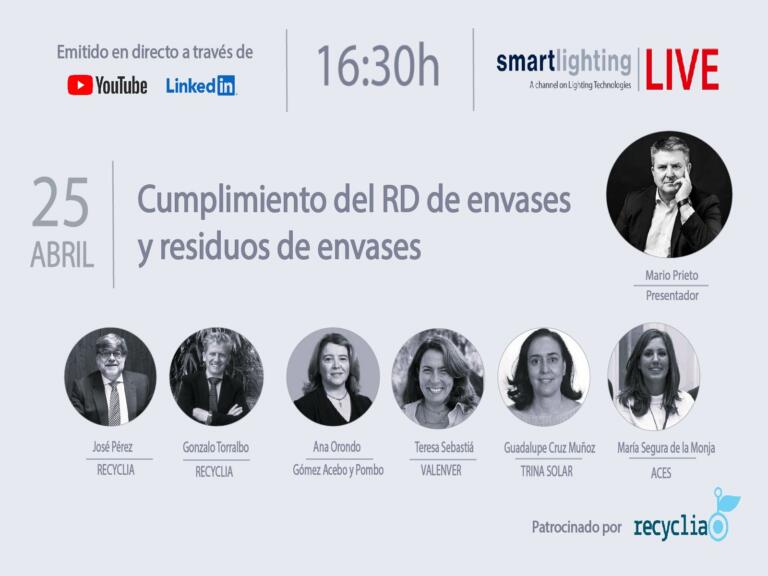By Miguel Cacheda
Did you know that LEDs can help improve your quality of life? That their light can be used for a variety of therapeutic treatments? That it can improve our performance at work and school? But not all about it is bright. Do you know that a luminaire with poor design may constitute a risk factor for diseases such as cancer or epilepsy? That its manipulation can cause long term damage to vision?
Whether you’re a designer of lighting systems, a user or an installer, what is presented in this post is interesting for you. Designers, you will be made aware of the features of the next generation luminaires, those which in addition to efficiency also provide the good light, the light we need. Consumers, you will learn what features a LED lighting system must include to suit your needs avoiding harm to your health or that of your family. And installers can learn some tips for setting good facilities and not bother about taking chances when it comes to handling luminaires with LEDs.
What parameters of the light can affect our health?
Light can affect our health in several ways [1 ] :
• The intensity of the light, with two possible effects:
• Warming of our eye
• Glare
• Strobe or flicker effects
• The spectrum of light
Let’s analyze each for the case of LEDs.
Effects of intensity of the LED light.
Eye warming?
We start with the good news. Normal use of an LED produces no heating effect of the eye. It appears clear that we are speaking about LEDs for lighting and not about laser LEDs that can be potentially hazardous.
Glare?
Concentration of light present in an LED light can easily exceed 1,000 times that of traditional light sources. These intensity levels can definitely cause annoying glares that are not harmful to health, except in potentially dangerous situations such as vehicles driving.
Thus, we have to prevent direct light from the LEDs reach our eyes. Therefore, the recommendation is not to use powerful lamps that have LEDs at sight.
Installers and designers already stick to visual ergonomic standards that avoid these annoying glares.
How does light flickering affect us?
The flicker or stroboscopic effect of light is present in nearly all sources of artificial light although our eye can’t observe it. There are studies [2 ] showing the possible effects of flickering in humans depending on frequency:
• ~ 3- 70Hz, risk of epileptic seizures
• Up to 165Hz risk of discomfort, headaches, impaired vision, etc. .
It has been demonstrated that we perceive flicker at frequencies up to 200Hz. But its effects depend on the sensitivity of the person (not all of us are affected equally) and on other parameters such as:
• Frequency
• Light intensity (higher intensities produce a greater effect)
• Color of light (red and blue affect harder)
• Modulation (difference between maximum and minimum value of light. Higher differences produce a greater effect)
Incandescent and fluorescent bulbs (including those of low-fluorescence consumption) are fed directly to 50Hz (60Hz in some countries) and therefore present flickering to the 50 -60Hz grid frequency and of twice the 100Hz- 120Hz grid frequency, above what our eye can perceive. In the following videos made in slow motion these flickers can be seen.
Video: flicker in incandescent lamp
Video: flicker in fluorescent lamp
Video: flicker in sodium lamp
Video: flicker in mercury lamp
The LEDs can’t be connected directly to the network (except for some not very popular exceptions) and to produce light, they must be fed with a steady current at a certain value. This current is provided by an electronic circuit that has a full range of accepted names (ballast, driver, power supply, power source, etc. . ) and which is responsible for this current to present the appropriate value and to be as stable as possible.
Okay, okay, but does the LED produce a flashing beam or not? We have to distinguish two cases:
• LED lighting without attenuation, dimming, NO ( if the design is appropriate) .
• In the case of including dimming:
o If the dimmer comes from the traditional lighting installation, not all LED lamps operate properly with these dimmers , therefore the appearance of visible and invisible flicker is likely.
o If the dimming function is in the LED lamp, flickering will exist as it is the usual way of performing dimming in an LED (PWM), but their frequency should be well above the 200Hz listed above.
In conclusion, flickering is in all sources of artificial light and also LED can have it. Assuming proper design of the LED lamp, flickering should be at frequencies above 200Hz to have the least effect on people. The next video made in slow motion allows observing the flickering of an LED bulb.
More details about LED flickering can be found in the following video from Finelite
Future posts will explain the differences, advantages and disadvantages of CCR and PWM power supplies for LEDs mentioned on the video. Keep following us!
So we can draw the following tips:
Designer:
• Dimming enabled ballasts have to do so with frequencies above 200Hz.
• Use of LEDs with a large luminous inertia, ie , that its materials allow the greatest flicker smoothing.
• Introduce sensors in the lamps to detect high risk flicker (mainly under 70Hz) due to poor facilities or malfunction, and disconnect the lamp.
Installer and consumer:
• Do not use classic lighting dimmers with LED lamps unless you are absolutely sure that the connection of both will not produce flicker.
• Use ballasts with dimming frequencies greater than 200Hz.
• Get information about the possible flickering that lamps may have before buying them.
How does the spectrum of light affect our lives?
There are numerous ongoing studies that assess the benefits of light of a particular wavelength (which determines the color of light) for the treatment of diseases: cancer, rheumatism, cosmetic treatments, etc. .
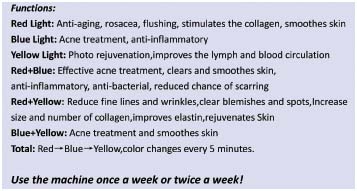 Cosmetic treatments with light offered in http://www.biostetics.com/light-therapy-bibio-light.html
Cosmetic treatments with light offered in http://www.biostetics.com/light-therapy-bibio-light.html
Sunlight keeps on varying its spectrum (its color composition) throughout the day. This spectrum has higher blue components during the day and redder at night. This variation of natural light has effects on the circadian rhythms of our body. That is, in our activity throughout the day.
Spectral distribution of natural light in the different directions of the sky [1]
Following video goes deeper into circadian rythms and light
We also know that our vision adapts throughout the day, being more sensitive to the blue colors at night. This allows defining 3 types of vision: photopic (day), mesopic (sunset) and scotopic (night) vision. Therefore the night lighting with blue hues (cool whites) needs less luminosity to provide the same sense of brightness to our eyes. Or which is the same, illuminating with light with a greater component of blue overnight, allows for energy savings. Detailed information about this topic can be found in this video from Osram
So does the LED have healing properties?
I think we should not exaggerate. Strictly speaking, it is the light that has effects on our organism. And the LED is the light source that enables us to create any light spectrum. Therefore they allow us to create lighting systems that improve our health.
Thus many experiments are already being undertaken with light therapy for cancer treatment with some encouraging results. But above all, there is evidence of the influence of blue light in our mood and our biological rhythms. Proper lighting has been shown to achieve:
• Improve mood and performance in the workplace
• Improves attention and reaction times
Therefore, appropriate lighting with LEDs can result in improving our mood , performance, etc, but it can also be used for treatment of depression, jet lag recovery, etc. .
Magnificent! Will LED lighting improve my health?
Not so fast! LED is the unique technology that can take advantage of the properties of light to improve our quality of life, the only one that is able to provide the right light for every moment. But it is not a miracle product. It also has its disadvantages that need be considered.
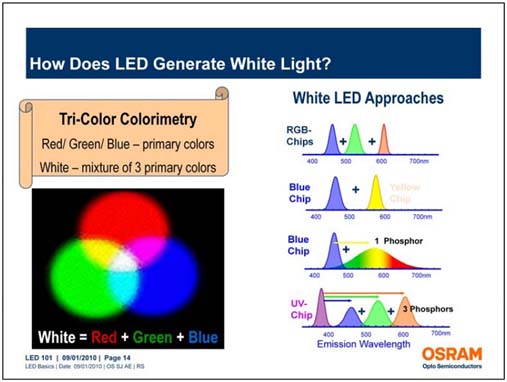 Methods for generation of white light with LEDs. Osram
Methods for generation of white light with LEDs. Osram
To create the white light emitting LEDs there are several methods outlined in the above picture and listed below:
1. By using at least three LEDs of different colors, typically red, green and blue
2. Through a blue LED with yellow phosphor (warm white)
3 . Through a blue LED with another phosphor (cool white)
4 . Using an ultraviolet LED and three phosphors
For reasons of cost and efficiency, the methods commonly used are 2 and 3. And the result is a spectrum of light with a significant blue component.
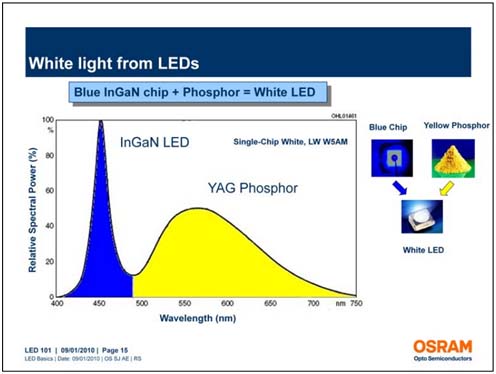 Spectrum of light of a White LED Osram
Spectrum of light of a White LED Osram
Perfect ! Blue light is perfect as you just mentioned it is best to increase the efficiency of night lighting and furthermore it has the ability to » tune us to the day mode » increasing our attention , performance, etc. .
No, it’s not so perfect. Blue light has good features but also:
• Causes eye damage degenerating eye tissues [3 ]
• It is toxic to tissues [ 1]
• It inhibits the production of melatonin which is related to lack of sleep, fatigue, stress, cancer (not proved yet although there is some evidence, etc.). , Etc. . [4]
You’ve convinced me …I won’t use LED lamps!
Wait! I just said that to make a white LED there are several methods. 1 and 4 do not produce blue light or rather the amount of blue light is controlled independently. So there is an alternative, albeit a bit more expensive. In addition, the types of phosphors used in the methods 2 and 3 are evolving much so that the blue component is steadily decreasing.
How to reduce the harmful effects of blue light when lighting with LED?
Several tips:
• Those who have to work exposed to bright lights with a significant blue component, should work with goggles that filter out blue light [1 ] . I think installers should take note of this recommendation.
• Children and people with hypersensitivity to blue, should not be exposed to intense cold white lights and preferably warm white lights should be used [1 ] .
• Do not use cold bright white lights at least three hours before bedtime (this includes computers, tablets, smartphones, etc.). [1 ] .
What will the new LED lighting generation be?
The new generation will be the one to make the leap of efficient lighting to good lighting. Ie taking into account:
• Zero flickering
• Adaptation of spectrum to the time of day and to our activity
• Control of the blue light emission
With current technology, this is already possible and therefore it is only up to us to realize that the «good light» can improve our quality of life.
References
[1] Anses, “Effets sanitaires des systèmes d’éclairage utilisant des diodes électroluminescentes (LED)”, http://www.anses.fr/sites/default/files/documents/AP2008sa0408.pdf
[2] Wilkins, A., Veitch, J. y Lehman, B., “LED Lighting Flicker and Potential Health Concerns: IEEE Standard PAR1789 Update”, http://www.xinelam.com/pdf/LED-Lighting-Flicker-and-Potential-Health-Concerns.pdf
[3] Elaine Kitchel, “The Effects of Blue Light on Ocular Health”, http://www.cclvi.org/contributions/effects1.htm
[4] Harvard Medical School, “Blue light has a dark side”, http://www.health.harvard.edu/newsletters/Harvard_Health_Letter/2012/May/blue-light-has-a-dark-side/
Other articles used
- Mike DeGregorio, “Switch From Fluorescent To LED Lighting”, http://getleducated.com/2013/08/16/switch-from-fluorescent-to-led-lighting/
- Joseph R. Knisley, “The Health Benefits of LED Lighting”, http://ecmweb.com/lighting-amp-control/health-benefits-led-lighting
- Cambridge University, “Low-cost LEDs for saving energy and improving health”, http://www.cam.ac.uk/research/news/low-cost-leds-for-saving-energy-and-improving-health


